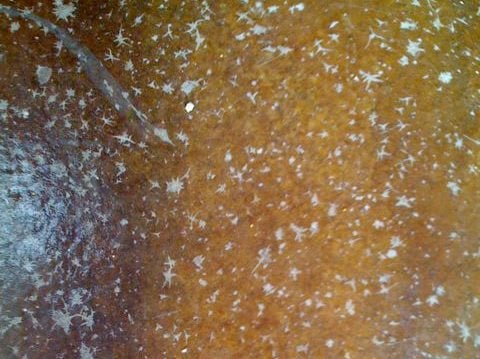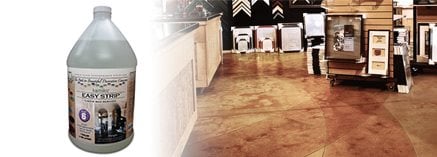- Concrete Sealers
- Comparison Chart of Concrete Sealers
- Buying Tips for Concrete Sealer Products
- Concrete Sealer Reviews: Sealer products other contractors use and recommend
- Common Questions about Concrete Sealers
- How to Remove Concrete Sealer
- Types of Sealers
- Acrylic Sealers
- Epoxy Sealers
- Penetrating Sealers
- Polyurethane Sealers
- Polyaspartic Sealers
- Application Surface
- Driveway Sealer
- Sealers for Stamped Concrete
- Concrete Floor Sealers
- Concrete Countertop Sealers
- Pool Deck Sealer
- Exposed Aggregate Sealer
Removing Concrete Sealers and Coatings with Chemical Strippers
Learn how the various types of chemical strippers work, how to choose the best one for your needs, and what safety precautions to take when using them
If your sealer has spots, bubbles, or discoloration you should have it removed and reseal your concrete.
Ask anyone who has ever stripped a sealer or coating from a concrete surface what they thought of the process, and I can pretty much guarantee you will get the same general reaction—misery. The process of removing old, worn or failing sealers or coatings from concrete ranks among one of the most miserable jobs a concrete professional may have to undertake. Unfortunately, it's often the only way to prepare, restore or repair a concrete surface.
Shop cleaners and degreasers
Find concrete contractors near me
SEALER REMOVAL METHODS
There are two methods for removing sealers from concrete:
- Mechanical, which consists of grinding, blasting or sanding the coating off the surface
- Chemical, using a chemical stripper to remove the the coating
While both work, the mechanical method often profiles or damages the surface to the point that translucent decorative finishes can no longer be applied. Mechanical removal also creates noise and dust, which can be difficult to deal with. This is why the most common method for removing sealers, paints or coatings from concrete is to use a chemical stripper.
TYPES OF CONCRETE SEALER REMOVERS
There are three categories of chemical strippers used to remove sealer from concrete:
- Caustic
- Solvent-based
- Biochemical
All three are readily available through concrete distribution houses, big-box outlets, hardware stores and specialty paint stores. No matter which category of stripper you end up using, be aware that they all contain harsh chemicals, and you need to read and abide by all the safety guidelines. Even the newer "green" or "environmentally friendly" strippers contain chemicals that can make you sick, so treat all chemical strippers with respect, and dispose of the waste material in accordance with local and state regulations.
 Easy Strip™ Wax Stripper
Water base, low VOC, Biodegradable, easy cleanup
Easy Strip™ Wax Stripper
Water base, low VOC, Biodegradable, easy cleanup
 Fast Strip Plus
High-powered, solvent-based sealer remover
Fast Strip Plus
High-powered, solvent-based sealer remover
 Coating Removal - Brickfrom Strip-It
Environmentally sound and user-safe stripper
Coating Removal - Brickfrom Strip-It
Environmentally sound and user-safe stripper
 600 GL Coatings Remover
Removes multiple layers in single application.
600 GL Coatings Remover
Removes multiple layers in single application.
 Nock-Off
Biodegradable commercial grade coatings stripper.
Nock-Off
Biodegradable commercial grade coatings stripper.
Caustic strippers
How they work. Caustic strippers are made from strong alkaline chemicals. The high pH of the alkaline causes the destruction of the coating film, allowing easy removal from the substrate.
When to use them. Caustic strippers are a good option when removing latex, alkyds or enamel paints from concrete. They are not a good choice for removing acrylic, epoxy or polyurethane coatings because these resins have good resistance to caustic chemicals. A caustic stripper also doesn't work well when temperatures are below 50F, and thicker-build coatings will require many applications, more so than with other types of chemical strippers.
Safety precautions. An advantage of caustic strippers is that they are generally less harmful and easier to handle than solvent-based strippers. Once the stripper has done its job, a neutralizing wash is required to remove the coating and any remaining stripper to prepare the concrete for the next process. Make sure to dispose of the waste material properly, as caustic strippers tend to stay active and can react with other chemicals even after they are removed from the concrete.
Solvent-based strippers
How they work. Solvent-based strippers are by far the most common type of stripper used today. The reason they are so popular is because they work fast, and a small amount of stripper goes a long way. Methylene-chloride based strippers are very popular, and work very well on all resin types and thicknesses. Other types of solvent strippers include N-methylpyrrolidone (NMP), dibasic esters (DBEs) and combinations of toluene, acetone and alcohol. Solvent-based strippers only work when they are wet, so taking steps to slow the evaporation of the solvent is important for product performance. Once the coating residue and any remaining stripper have been removed, cleanup consists of scrubbing with soap and water followed by rinsing with clean water. Using a high-pressure washer is recommended.
When to use them. Most professional applicators like to use solvent-based strippers because they are fast, aggressive and will remove almost all types of coatings or sealers in one or two applications. The common sealer resins used on concrete (acrylic, epoxy, polyurethane, polyaspartic and polyurea) are no match for a good solvent-based chemical stripper. However, these products are more effective when used in cool, draft-free conditions because heat and wind tend to cause rapid solvent evaporation and slow or stop the stripping process.
Safety precautions. Extreme caution should be used when working with methylene-chloride-based strippers, as they can cause severe skin irritation and permanent liver damage if used excessively. The other types of solvent strippers are less harmful to work with, but tend to evaporate quickly and can be highly flammable. Good ventilation is always important when using solvent-based strippers, so open windows and doors, and keep fans running to circulate the air.
Biochemical strippers
How they work. Biochemical strippers are the newest category of stripper, growing steadily in popularity and availability over the last five years. Their popularity stems from their sustainability (they are made from natural plant material) and low environmental impact (they contain no solvents or harsh caustic chemicals). The active ingredients found in biochemical strippers are typically acids or esters derived from plants. Common plant sources include pine oil, corn sugars, citric acid and soy oil.
When to use them. I have found that most professional installers will only use biochemical strippers if the work being done is in an environmentally sensitive area where solvent odors, stripper overspray or rinse water could potentially kill grass, plants or trees. Biochemical strippers are the easiest of the stripper categories to work with, have the least offensive odor, and are often considered to be eco-friendly. However, they are the least aggressive type of stripper and need to remain on the surface for long periods of time to get the job done. Coating thickness also has a major effect on the amount of stripper needed and how long it needs to stay on the surface. I have seen it take 12 to 24 hours for a biochemical stripper to remove a thick-build epoxy from a concrete floor.
Safety precautions. Most biochemical strippers do contain N-methylpyrrolidone (NMP), which can cause minor skin irritation.
CHOOSING THE RIGHT CHEMICAL STRIPPER FOR THE JOB
What are you trying to remove?
Choosing the right chemical stripper for your particular project depends on a few key factors. Knowing what type of sealer or coating you are trying to remove is usually the most important. There are major differences between acrylics, polyurethanes and enamels. You typically want to match the strength of the stripper to the strength of the sealer. High-performance or thicker polyurethane and epoxy-based sealers are removed faster and more efficiently with a more aggressive solvent-based stripper. For thinner acrylic-type sealers, a biochemical or caustic stripper may be sufficient.
Knowing even a little about what you are trying to remove can go a long way in choosing the stripper that will be most the cost and time effective. If you have no idea what type of coating or sealer was used, here are some basic guidelines that can help:
- Is the concrete inside or outside? Most interior sealers or coatings are acrylic.
- How thick is the sealer or coating? Thicker sealers or coatings (as thick as dime or greater) are usually high-performance epoxies or polyurethane-based systems, while thinner sealers (thickness of paper) tend to be acrylics or enamels.
What is the condition and thickness of the sealer?
Once you have identified the type of sealer, or at least have categorized it as an acrylic or non-acrylic, you need to look at the condition and thickness of the sealer. Is the sealer in good shape and adhering well to the concrete, or is it loose, flaking, and coming off easily. You'll need to use an aggressive solvent-based stripper to remove sealer that is in good condition and well-adhered. For a sealer that is loose, weak or failing, you may be able to use a less-aggressive biochemical stripper.
Where is the work being done?
The other factor to consider is the location of the concrete to be stripped and the environmental impact of the type of stripper you use on surrounding plant life, structures and people. Safety should always come first when considering the type of stripper to use.
Solvent-based strippers are the most aggressive and generate odor and possibly flammable fumes. Do not use these strippers in areas where sparks or open flames will be present. I also tend to stay away from using solvent-based strippers in public areas or places where the fumes can travel through HVAC systems and reach locations where people are working or living. The fumes given off by solvent strippers can be more dangerous than the actual stripper itself. In these situations, the new generation of eco-friendly biochemical strippers works very well.
Both caustic and solvent-based strippers will kill most plant life they come in contact with, as well as contaminate water in ponds and tanks where fish may be living.
As a side note, I have been involved with many successful projects where solvent-based strippers were used in public locations to remove stubborn high-performance sealers. It all comes down to managing the jobsite, providing adequate ventilation, and taking the proper safety measures.
Are you removing a specialty floor wax or finish?
There is another category of stripper specially formulated to remove floor waxes or finishes. These specialized strippers are often alcohol-based and are not as aggressive as other standard chemical strippers. Most are water-based and are designed to only remove the wax or maintenance topcoat finish without affecting the underlying sealer. Some manufacturers make strippers that will only target the specific chemical makeup of their floor wax or finish.
CHEMICAL STRIPPER APPLICATION TIPS
How to Remove an Acrylic Concrete Sealer with BRICKFORM STRIP IT
Time: 02:59
Keep the stripper active
The most important factor when working with chemical strippers is to keep the stripper "active," or wet. If the stripper dries out, it stops working. This is why most strippers come in a gel or paste form. The gel consistency also makes for easier application, but its main purpose is to help slow evaporation, which allows the stripper to stay active for longer periods of time.
How to prevent chemical strippers from drying too quickly:
- Using damp burlap or cotton sheets to cover areas is an easy way to reduce evaporation and keep the stripper active.
- Avoid exposing outdoor areas being chemically stripped to direct sun and wind.
- Another good tip is to place a plastic sheet over the cotton or burlap to prolong the active life of the stripper even more.
- Do not let the plastic sheets come in direct contact with the chemical stripper itself, since many strippers are likely to destroy the plastic.
- Work in small, manageable sections to allow for easier application and, more importantly, easier cleanup.
Remove and safely dispose of the mess
Once a chemical stripper has done its job, you are left with a gooey mess. This goop consists of the stripper gel and the now-liquefied sealer. All of this goo MUST come off the concrete.
On smooth concrete, a flat bladescraper is the best tool for the job. Scrape the stripper and sealer residue into a nonreactive bag or container, and repeat the process until the concrete is free of any solid material. Be sure to dispose of the waste in accordance with local and state environmental regulations.
Unfortunately, the scraper method does not work well on textured or stamped concrete surfaces. In those cases, using a stiff-bristle nonreactive scrub brush or broom in place of the scraper works best. Make sure to focus on the pattern indentations and textured areas where the sealer tends to hide.
Once the scraping and scrubbing is complete, cleaning up with soap and water is recommended. A great tip I learned from a professional floor preparation contractor years ago was to use hot water and a high pressure washer. The hot water makes all the difference in removing any remaining stripper and sealer residue. At this point, a determination can be made if additional stripper is required or the floor can be rinsed and the next phase of work can begin.
Read all the directions
The most important tip I can share is actually the simplest: Read all the directions and application guidelines for the stripper you are using. Each product has different requirements for application, cleanup and safety precautions based on its particular chemistry. I always default to the manufacturer's recommendations before relying on my own application and cleanup procedures.
There is no doubt that stripping sealers from concrete is a miserable job. The process can be a lot less painful, however, if you understand how the products work and how to best match a stripper to your particular job. This knowledge will help you streamline the process and produce a better outcome.
Alternative option for removing sealers and coatings: Soda Blasting




